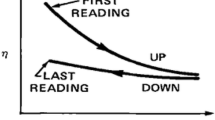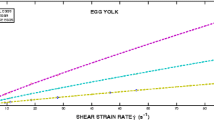Abstract
Thermophysical properties of eggs was studied in a temperature range of 5–60 °C, which could be used to optimize the thermal processing. The effective thermal conductivity of egg white was predicted by Krischer model (fλ = 0.20), and for egg yolk, parallel model was in good agreement with the experimental data. Power law and Herschel–Bulkley models were used to describe rheological behavior of egg yolk and white, respectively. The differential scanning calorimeter showed that denaturation of white protein starts at 60 °C. Surface heat transfer coefficient increased with increasing temperature. Density decreased during thermal process and was in a good agreement with the predictive models, based on the chemical component.










Similar content being viewed by others
References
W.J. Stadelman, O.J. Cotterill, Egg Science and Technology, 4th edn. (The Haworth Press, New York, 1995)
S. Denys, J.G. Pieters, K. Dewettinck, Computational fluid dynamics analysis of combined conductive and convective heat transfer in model eggs. J. Food Eng. 63(3), 281–290 (2004)
E. Shenga, R.P. Singh, A.S. Yadav, Effect of pasteurization of shell egg on its quality characteristics under ambient storage. J. Food Sci. Technol. 47(4), 420–425 (2010)
S.R.S. Dev, V. Orsat, Y. Gariépy, G.S.V. Raghavan, C. Ruiz-Feria, Selected post-heating properties of microwave or hot water heated egg white for in-shell pasteurization. Int. J. Food Prop. 13(4), 778–788 (2010)
A.L.A. Hema, Effect of different pasteurization methods of egg in shell on survival of Salmonella enteritidis. In Animal Wealth Research Conference. In the Middle East & North Africa, Animal Health Research Institute, (Food Hygiene Department, Egypt, 2011), pp. 107–120
P. Punidadas, R.C. Mckellar, Selected physical properties of liquid egg products at pasteurization temperatures. J. Food Process Preserv. 23(2), 153–169 (1999)
F. Erdogdu, M. Ferrua, S.K. Singh, R. Paul, Singh, air-impingement cooling of boiled eggs: analysis of flow visualization and heat transfer. J. Food Eng. 79(3), 920–928 (2007)
American Egg Board (2012), http://www.aeb.com
H. Hou, R.K. Singh, P.M. Muriana, W.J. Stadelman, Pasteurization of intact shell eggs. Food Microbiol. 13(2), 93–101 (1996)
J.S.R. Coimbra, A.L. Gabas, L.A. Minim, E.E. Garcia Rojas, V.R.N. Telis, J. Telis-Romero, Density, heat capacity and thermal conductivity of liquid egg products. J. Food Eng. 74(2), 186–190 (2006)
A.O.A.C. Aoac, Association of Official Analysis Chemists (INC, Virginia, 1984)
AOCS, Official Methods and Recommended Practices of the American Oil Chemists Society, (The American Oil Chemists Society, Washington DC, 1993)
AOAC, The official methods of analysis. In vol. Method 28.074, (Arlington, 1984)
P.E. Liley, R.C. Reid, E. Buck, Physical and Chemical Data. In Perry’s Chemical Engineers’ Handbook, 7th edn. (McGraw-Hill, New York, 1984)
M. Shariaty-Niassar, M. Hozawa, T. Tsukada, Development of probe for thermal conductivity measurement of food materials under heated and pressurized conditions. J. Food Eng. 43(3), 133–139 (2000)
B.R. Becker, B.A. Fricke, Food thermophysical property models. Int. Commun. Heat Mass. 26(5), 627–636 (1999)
M.S. Baghe-Khandan, Y. Choi, M.R. Okos, Improved line heat source thermal conductivity probe. J. Food Sci. 46(5), 1430–1432 (1981)
D.S. Mcginnis, Automated line-heat source system for the measurement of thermal conductivity and diffusivity. Can. Agric. Eng. 29(2), 201–207 (1987)
N. Hamdami, J.-Y. Monteau, A. Le Bail, Effective thermal conductivity of a high porosity model food at above and sub-freezing temperatures. Int. J. Refrig. 26(7), 809–816 (2003)
N. Hamdami, J.-Y. Monteau, A. Le Bail, Thermophysical properties evolution of French partly baked bread during freezing. Food Res. Int. 37(7), 703–713 (2004)
M. Ferreira, C. Hofer, A. Raemy, A calorimetric study of egg white proteins. J. Therm. Anal. 48(3), 683–690 (1997)
S. Mahadevan, Differential scanning calorimetric studies of native and freeze-damaged very low density lipoproteins in hen’s egg yolk plasma. J. Biosci. 11(1–4), 299–309 (1987)
J. Telis-Romero, C.E.P. Thomaz, M. Bernardi, V.R.N. Telis, A.L. Gabas, Rheological properties and fluid dynamics of egg yolk. J. Food Eng. 74(2), 191–197 (2006)
C.F.C.M. Fong, G. Turcotte, D. De Kee, Modelling steady and transient rheological properties. J. Food Eng. 27(1), 63–70 (1996)
M.R. Rosen, Characterization of non-Newtonian flow. Polym-Plast. Technol. 12(1), 1–42 (1979)
C.-P. Elena, Non-Newtonian models. In Encyclopedia of Agricultural, Food, and Biological Engineering, 2nd edn, (Taylor & Francis, Boca Raton, 2010), pp. 1134–1137
M.R. Atilgan, S. Unluturk, Rheological properties of liquid egg products (LEPS). Int. J. Food Prop. 11(2), 296–309 (2008)
N. Hamdami, J.-Y. Monteau, A. Le Bail, Transport properties of a high porosity model food at above and sub-freezing temperatures. Part 1: thermophysical properties and water activity. J. Food Eng. 62(4), 373–383 (2004)
E. Ibanoglu, E.A. Erçelebi, Thermal denaturation and functional properties of egg proteins in the presence of hydrocolloid gums. Food Chem. 101(2), 626–633 (2007)
Author information
Authors and Affiliations
Corresponding author
Rights and permissions
About this article
Cite this article
Abbasnezhad, B., Hamdami, N., Shahedi, M. et al. Thermophysical and rheological properties of liquid egg white and yolk during thermal pasteurization of intact eggs. Food Measure 8, 259–269 (2014). https://doi.org/10.1007/s11694-014-9183-6
Received:
Accepted:
Published:
Issue Date:
DOI: https://doi.org/10.1007/s11694-014-9183-6




